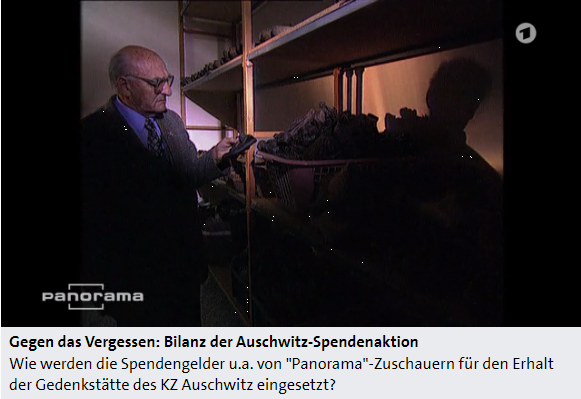On November 19, 1998, NDR editor Patricia Schlesinger reported in the magazine “Panorama” about the use of donations that ARD viewers had donated over several years to build and maintain the Auschwitz concentration camp memorial.
„The fall of the Iron Curtain also opened paths leading back into the darkest chapter of German history. The Norddeutscher Rundfunk (NDR) was one of the first broadcasters to report on the museum that organizes the Auschwitz Memorial and, in 1992, called for the preservation of the historical site of Auschwitz. The former concentration camp threatened to fall into disrepair. Over the years, television viewers had donated a total of nearly three million marks. In 1996, it was reported what had happened with the money.
It is now more than fifty years since they were murdered here: Jews, Poles, Gypsies, gassed, cremated, and exterminated. Most of the prisoners’ barracks have long since fallen into disrepair. Only the chimneys are still standing. We meet Jozef Matinya. He survived. He was not able to help any of his fellow prisoners. But for more than fifty years, he has been fighting to ensure that at least the dead of Auschwitz are not forgotten. That, he thinks, is something we all owe them. Jozef Matinya shows us one of the barracks restored with donations. The beams and the bunks have been impregnated. The inscriptions of the murderers have thus also been preserved—cleanliness and health. Thanks to the donations, it was possible to transcribe the descriptions of survivors and record these in a register.“
– Patricia Schlesinger, editor and presenter of „Panorama“ NDR

„On a practical level, we are, of course, very pleased terms that we were able to realize many tasks relating to conservation tasks and other things. But sometimes, I would say, it is more important for us to know that so many people are still intensively preoccupied with the topic of Auschwitz after more than fifty years. That means for us a kind of moral support.“
– Krystyna Oleksy, Deputy Director of the Auschwitz-Birkenau Memorial
„Jozef Matinya goes with us to the main camp. Here was his cell. The stone barracks were also restored, now housing offices and archives. Jozef Matinya wishes to show us the photo labs: This is very important to him. 40,000 photos are preserved in Auschwitz, 40,000 of millions. Because, for the most part, their deterioration cannot be halted, they are rephotographed, for scholars and relatives. The faces of Auschwitz. Half of the cost for this microfilm camera was raised with donations, the other half was donated by the Holocaust Museum in Washington. Personal mail, lists, all important documents are preserved for posterity. For Jozef Matinya, the photos are invaluable. It is as if the past is looking at him: Jozef Matinya, eighteen years old.“
– Patricia Schlesinger
„Nothing can really reflect the horror or the crimes that happened here,” he says, “not even fifty percent of it can be processed retrospectively. But these objects must be preserved as evidence. This is my thirtieth time in Auschwitz, but it keeps attacking me. Young people must understand what happened here.“
– Jozef Matinya, former prisoner
„The suitcases. Many people were simply wrenched from their homes, most of them told that they would be taken to a place in the East where they would feel better. They packed and traveled to their deaths. The suitcases are now preserved, each piece of luggage individually, depending on material, condition, and age. There are still roughly 100,000 shoes in Auschwitz. They are rotting in rooms without air conditioning and with large fluctuations in temperature. For a long time, they could not be preserved because the funds were lacking. Now, made possible by donations, they are being individually catalogued and saved from deterioration. For Jozef Matinya, they are the worst, especially the shoes of the children killed in Auschwitz.’“
– Patricia Schlesinger
- From: “Against forgetting” – balance of an NDR fundraiser for Auschwitz, NDR/Panorama, November 19, 1998
